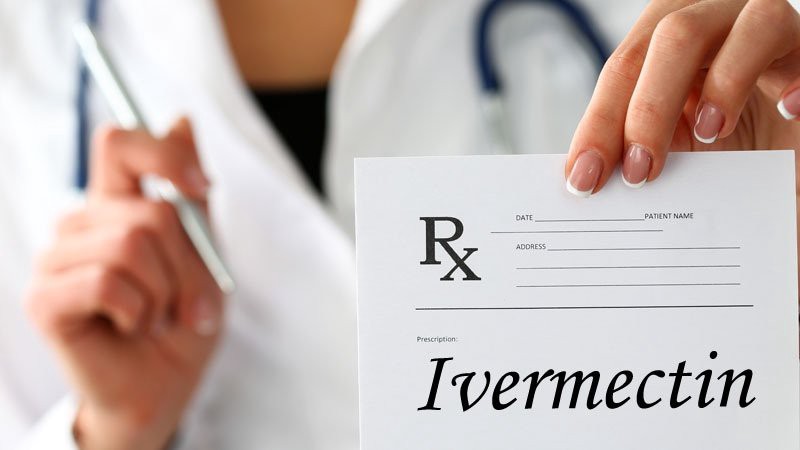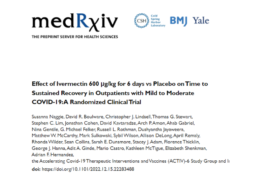Medscape
Ken Terry
January 14, 2022
Commercial and Medicare Advantage insurers are spending an estimated $129.7 million annually on ivermectin prescriptions for COVID-19, even though the antiparasitic drug has not been shown to be effective against the virus, according to a new JAMA study.
The researchers analyzed a sample of a prescription drug database covering the period from December 1, 2020, through March 31, 2021.
Ivermectin prescriptions for COVID-19 surged in the United States at the end of 2020, according to the paper.
The investigators identified oral ivermectin prescriptions dispensed during the study period, excluding those for patients who lacked continuous enrollment or who had a diagnosis code for a parasitic infection during the week before the prescription. The researchers assumed the remaining prescriptions were for COVID-19.
Of the 5939 ivermectin prescriptions written in this sample, 348 (5.9%) were excluded. Of the remaining 5591 prescriptions, 4700 (84.1%) were for privately insured patients. The mean age of those patients was 51.8 years.
Mean out-of-pocket spending on the ivermectin prescriptions was $22.48 for privately insured patients and $13.78 for Medicare Advantage patients.
Mean insurer reimbursement was $35.75 and $39.13, respectively.
Aggregate total spending was $273,681 for privately insured patients and $47,143 for Medicare Advantage patients, of which insurer reimbursement represented 61.4% and 74%, respectively.
To assess the potential magnitude of US insurer spending on ivermectin prescriptions for COVID-19, the authors estimated private and Medicare plan spending on these prescriptions during the week of August 13, 2021, the most recent week for which dispensing data were available. They used their analysis of the earlier sample to inform those estimates.
The researchers assumed that all 88,000 ivermectin prescriptions dispensed in that week were for COVID-19, except for 3600, the average weekly dispensing total in the 12 months before the pandemic.
They also assumed that 52% (43,888) and 28% (23,632) of the remaining 84,400 prescriptions were paid by private and Medicare plans, reflecting the overall distribution of payer type for US prescriptions.
In the week of August 13, 2021, private and Medicare plans paid an estimated $1,568,996 and $924,720, respectively, for ivermectin prescriptions for COVID-19, the study shows.
Multiplying those amounts by 52 weeks yielded an estimated total annual payment of $129,673,240.
Restrict Coverage?
The authors noted that this wasteful spending exceeds the estimated annual Medicare spending on unnecessary imaging for low back pain.
The amount of waste, they said, is even higher because their estimates don’t include Medicaid spending.
And, by encouraging some people not to get vaccinated, they maintained, the unwarranted ivermectin prescriptions probably resulted in additional COVID-19 cases that would have increased insurance costs.
The researchers suggest that insurance companies restrict ivermectin coverage by requiring prior authorization of the drug.
These restrictions could reduce wasteful spending, they noted, while impacting only a small number of patients who had conditions for which the drug is indicated.
Originally published at https://www.medscape.com on January 14, 2022.
ORIGINAL PUBLICATION (long version)

US Insurer Spending on Ivermectin Prescriptions for COVID-19
Kao-Ping Chua, MD, PhD1; Rena M. Conti, PhD2; Nora V. Becker, MD, PhD3
January 13, 2022
Ivermectin dispensing surged in the US in December 2020, even though evidence suggests ivermectin is ineffective for COVID-19.1,2 Studies have not assessed the degree to which insurers cover the costs of ivermectin prescriptions for COVID-19 or estimated wasteful US insurer spending on these prescriptions. We addressed these gaps by using national claims data from December 1, 2020, through March 31, 2021.
Methods
We conducted a cross-sectional analysis of the IQVIA PharMetrics Plus for Academics database. During the study period, the database included a convenience sample of 5 million patients with private insurance and 1.2 million with Medicare Advantage across the US. Compared with all US patients with private and Medicare Advantage insurance, the database contains a higher proportion of patients residing in the Midwest and a lower proportion of patients residing in the South. Because data were deidentified, the institutional review board of the University of Michigan Medical School exempted analyses from review.
We identified oral ivermectin prescriptions dispensed during the study period, excluding those for patients who lacked continuous enrollment or had a diagnosis code for a parasitic infection (B65.xxx-B89.xxx) during the 7 days before dispensing. We assumed the remaining prescriptions were for COVID-19. This approach maximized sensitivity because it captured prescriptions written during visits in which COVID-19 was not coded and during visits not billed to insurance.
For each payer type, we calculated mean insurer reimbursement, out-of-pocket spending (deductibles plus coinsurance and co-payments), and total spending (insurer reimbursement plus out-of-pocket spending) per prescription. To assess the degree to which insurers covered prescription costs, we divided aggregate insurer reimbursement across prescriptions by aggregate total spending.
To assess the potential magnitude of US insurer spending on ivermectin prescriptions for COVID-19, we estimated private and Medicare plan spending on these prescriptions during the week of August 13, 2021, the most recent week for which dispensing data were available.2 We assumed that all 88 000 ivermectin prescriptions dispensed that week were for COVID-19 except 3600, the average US weekly dispensing total in the 12 months before the pandemic2; that 52% (43 888) and 28% (23 632) of the remaining 84 400 prescriptions were paid by private and Medicare plans, mirroring the overall distribution of payer type for US prescriptions3; and that our estimates of insurer reimbursement per prescription generalized to all private and Medicare plans. We multiplied by 52 to estimate annual spending. Analyses used SAS version 9.4.
Results
Of 5939 ivermectin prescriptions, 348 (5.9%) were excluded. Of the remaining 5591 prescriptions, 4700 (84.1%) were for privately insured patients. Mean patient age was 51.8 years (SD, 15.7 years) (Table 1).

Among ivermectin prescriptions, mean (SD) out-of-pocket spending was $22.48 ($24.78) for privately insured patients and $13.78 ($26.24) for Medicare Advantage patients; mean insurer reimbursement was $35.75 ($50.63) and $39.13 ($40.18), respectively; and mean total spending was $58.23 ($51.47) and $52.91 ($42.47), respectively. Aggregate total spending was $273 681.00 for privately insured patients and $47 142.81 for Medicare Advantage patients, of which insurer reimbursement represented 61.4% and 74.0%, respectively (Table 2).
In the week of August 13, 2021, private and Medicare plans paid an estimated $1 568 996.00 (43 888 × $35.75) and $924 720.16 (23 632 × $39.13) for ivermectin prescriptions for COVID-19. The weekly total of $2 493 716.16 extrapolated to $129 673 240.30 annually.
Discussion
Findings suggest that insurers heavily subsidized the costs of ivermectin prescriptions for COVID-19, even though economic theory holds that insurers should not cover ineffective care .4
Wasteful insurer spending on these prescriptions, estimated at $2.5 million in the week of August 13, 2021, would extrapolate to $129.7 million annually.
For perspective, this total exceeds estimated annual Medicare spending on unnecessary imaging for low back pain, a low-value service that has received extensive attention.5
The true amount of waste is even higher because estimates did not include Medicaid spending. Moreover, by reducing barriers to a drug that some individuals use as a substitute for COVID-19 vaccination or other evidence-based care, insurance coverage could increase spending for COVID-19 complications.
Limitations of this study include unclear generalizability to all private and Medicare plans. Despite this, findings suggest insurers could prevent substantial waste by restricting ivermectin coverage; for example, by requiring prior authorization.
Although these restrictions might impede ivermectin use for non–COVID-19 indications, low prepandemic levels of dispensing suggest this use is infrequent.2 Consequently, the restrictions could reduce wasteful spending, and the number of patients who would experience barriers to evidence-based treatment for ivermectin would be small.
References
See original publication
About the authors & affiliations
Kao-Ping Chua, MD, PhD1; Rena M. Conti, PhD2; Nora V. Becker, MD, PhD3
- 1Susan B. Meister Child Health Evaluation and Research Center, University of Michigan Medical School, Ann Arbor
- 2Department of Markets, Public Policy, and Law, Questrom School of Business, Boston University, Boston, Massachusetts
- 3Division of General Medicine, University of Michigan Medical School, Ann Arbor











